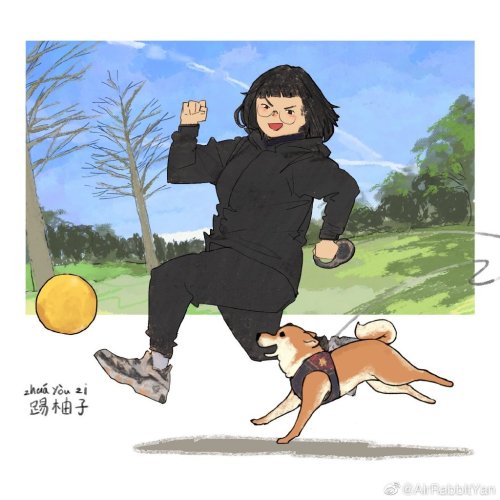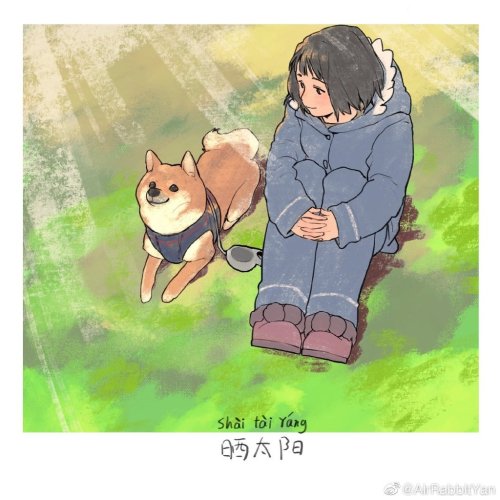Lemon Cake With Homemade Blueberry Compote + Blueberry Lemon Buttercream Decorated With White Strawberries


lemon cake with homemade blueberry compote + blueberry lemon buttercream decorated with white strawberries and edible glitter ! 🍓🫐🍋
More Posts from Lia-kotik-blog and Others











©AirRabbitYan
So... how do you say "rice" in Chinese?

Seems like an easy question, right? In some languages it certainly would be, but since rice has been a staple crop of parts of what is now China for at least 10,000 years, Mandarin Chinese has developed a lot of ways to talk about rice. In this post, I'm going to walk you through not two but three characters that mean rice and how they are used.
#1: 飯 (S: 饭) fàn

This is probably the first rice word that most learners learn. It means cooked rice, and because of how central rice is to many people's diets it also means meal and can be used metaphorically to refer to one's livelihood.
飯 is used in the names of dishes like 炒飯 (炒饭) chǎofàn "fried rice" and 滷肉飯 (卤肉饭) lǔròufàn "Taiwanese braised pork rice". In the sense of "meal", it is used in the words 吃飯 (吃饭) chīfàn "to eat a meal", 做飯 (做饭) zuòfàn "to cook" and 飯館 (饭馆) fànguǎn "restaurant".
#2: 米 mǐ

This is usually the second rice character that learners encounter. It means uncooked rice.
米 is used in words that refer to rice as an ingredient, such as 米粒 mǐlì "grain of rice" and 糯米 nuòmǐ "sticky rice". It is also used in the names of ingredients and dishes in which rice is processed in some way instead of being served boiled/steamed, such as 米粉 mǐfěn "rice flour, rice noodles" or 米豆腐 mǐdòufu "rice tofu". Finally, the character 米 also appears in the names of certain non-rice grains, such as 玉米 yùmǐ "corn" and 小米 xiǎomǐ "millet".
#3: 稻 dào

This is the character that most learners can go a long time without encountering. It means rice plant or paddy. It's mainly seen in words somehow relating to the cultivation of rice.
There are multiple words that can mean "rice paddy", such as 稻穀 (稻谷) dàogǔ or 稻田 dàotián. 稻 also appears in words that refer to parts of the rice plant, like 稻草 dàocǎo "rice straw" or 稻穗 dàosuì "rice ear". Finally, 稻 is used in words referring to various crops of rice, such as 早稻 zǎodào "early-season rice" or 晚稻 wǎndào "late-season rice".
Putting It All Together
Just because these words have distinct meanings doesn't mean they can't overlap! In fact, they can be combined to make new ways to say rice. 米飯 (米饭) mǐfàn means "cooked rice", and 稻米 dàomǐ means "rice (crop)". But can you combine 飯 and 稻? You can't-- they are just too far apart in meaning.
So there you have it-- three characters for rice. This is just a small snapshot of all rice-related vocab in Chinese, but I guarantee almost all of it contains one of these three characters. Do you have a favorite rice-related word? Or do you speak a language with many different ways to talk about a staple food?
Typing Pinyin Tones (macbook & iphone)
((I have apple products so I can't speak for windows computers or other brands. PLEASE add to this if you know how to do this for other products!))
Have you, like me, been typing everything into google translate to copy and paste the pinyin of words?
Have you, like me, been using the english keyboard holding button trick to get accents to pop up for à á ā and been using â for a 3rd/low tone because that was your only option??
NEVER AGAIN FRIENDS!
Typing Tones on an iPhone
First, you must have a pinyin-based Chinese keyboard on your phone. I'm assuming if you're learning Chinese you probably already have this?? So I'm skipping that part.
Go to the place where you want to type the pinyin and switch to your pinyin chinese keyboard
Hold the vowel you want and above it, the 4 tones will pop up
Slide your finger over to the on you want and let go (see image below)
That's it?? You now have pinyin and the suggestions for characters will go away!!

Typing Pinyin on a Macbook Computer
This is a bit trickier, bear with me.
Go to Settings/System Preferences
Go to Keyboard > Input Sources
Hit the little plus sign

4. Hit ABC - Extended and then hit "add"

Okay, you now have access to all four tone marks you need! You just need the codes for how to type it! These are the codes, you type these before any vowel to get the tone you want.
Option⌥ + a = 1st/high tone (ā)
Option⌥ + e = 2nd/rising tone (á)
Option⌥ + v = 3rd/low tone (ǎ)
Option⌥ + ` (just below escape key) = 4th/falling tone (à)
Note: for ü with an accent, you can use the above codes + v (e.g. ⌥ + a + v = ǖ)
If you ever forget, you can go up to your language input at the top header by the bluetooth/battery buttons and click "Show Keyboard Viewer." This will show you all the keys and when you press and hold Option⌥, it will show you all the possible key combinations (plus all the other features on this extended keyboard, it has quite a bit compared to the regular one!!)

Hope this was helpful!!! I'm so excited that I never have to go back and forth from google translate ever again :D

Moonlight At Suzhou ,China - Elizabeth Keith , 1924.
Scottish, 1887-1956
Woodblock , 17 -¼ x 13 -½ in.
Tips for Writing Sentences in a Foreign Language - for Beginners
Having studied 3 foreign languages at varying degrees of intensity and success - Japanese (I flatter myself to be fluent), Spanish (I can ask some simple questions and possibly crudely insult someone), French (I can say a few well-sounding phrases and then smile & nod when you respond). When beginning studies in languages, one of the most challenging things is to jump from the set beginner phrases from the textbook into creating your own sentences (gasp).
From my own language studies, plus experience TA'ing first year Japanese, I have a few tips for beginners on taking that leap into creating your own sentences. These will probably lean heavily on Japanese because that is the language I have the most experience with, but they are applicable to other languages too.

1. Just start making sentences!
It sounds simple, but it's the best way to start. Writer's block? Write about what you are doing, what you want to do, or write an introduction. Worried about speaking? Talk to yourself about what you are doing, what you want to do, or introduce yourself to yourself. You don't have to write or say anything world-shaking, but getting started is the first step. You can start by modeling sentences you've already seen. If you have an example textbook sentence, try modifying it to make your own similar sentence.
PS. Your sentences don't have to be perfect either. If you notice a mistake later, just go back and correct yourself!
2. Don't try to translate the phrase from your native language EXACTLY into your target language.
Languages don't always translate exactly, but also, sometimes your skill isn't advanced enough to say the same things you can say in your native language. If you don't yet know the appropriate grammar, vocabulary, or syntax of what you want to say, not being able to say exactly what you want can be frustrating and lead you to feel defeated (personal experience here). Instead, think of how to put the idea you have into a sentence using the knowledge you DO have.
If you have just started learning a language, it might be too much to directly translate "Entities should not be multiplied unnecessarily" (thanks, Ockham's Razor). Instead, why not try to translate "Simple is best"?
3. Avoid heading straight for the dictionary if possible when there is a word you don't know in your target language.
If you don't have the vocabulary word you need in a sentence, you might be tempted to go to the dictionary and look it up and throw it into your sentence. Whilst TA'ing first-year Japanese, this led to me puzzling and scratching my head over what the student was trying to say in their homework (hey, it's not my first language either!).
While using the dictionary to learn new vocabulary is obviously a must, when you are just starting out with sentence building it can also be a roadblock. When conjugating verbs is new to you, try using the verbs you do know to explain your idea. If you don't know a vocabulary word, selecting the right one for your context from a list of words with similar definitions can be difficult. If you don't quite know how to explain what you want to say, try rephrasing it until you can compose a less complicated sentence. Or break it into several sentences - you can work on complicated sentences when you're more comfortable with simpler ones!
Another bonus is that learning to explain what you want to say in your target language when you don't know the vocabulary is a helpful lifelong skill (that I still use today in Japanese). It can be frustrating to not be able to say exactly what you want to say in your target language at first, but if you just keep practicing you will get there.
4. Practice making sentences on the fly.
Writing allows you more time to think out the sentence, go back and make changes, and work things out more slowly. Speaking, on the other hand, is more challenging because you have to make your mouth form the words you are thinking, and do your best to make the sentence make sense to your listener. While writing sentences helps me to remember how to write hiragana/katakana/kanji and reinforces grammar (I learn best by writing it out!), speaking out loud helps your brain and your mouth learn to work together in your target language.
Don't have anyone to talk to? That's ok! Talk to yourself. Talk to your imaginary friends. Talk to your pet or your houseplant or your favorite figurine or stuffed animal. Just practice putting sentences together out loud, in real time. I promise you will notice improvement if you practice daily!
5. Don't be afraid of making mistakes!
But even if you do just throw in the dictionary word and your professor/study buddy/language exchange partner has to ask you what you were trying to say, that's ok! Making mistakes is ok! That's how you learn. Don't be afraid to be wrong, to be mocked and ridiculed.. ok, you most likely won't be mocked and ridiculed. (If you are, please find new language friends.)
Language learning is about making mistakes. Even now, after YEARS of studying and speaking and even doing interpretation/translation... I make mistakes (gasp). And it's ok. Ok, sometimes I think about the mistakes I have made in conversation in the middle of the night, but I'm working on that too. One day, you'll look back, and realize that agonizing over particles and which kanji to use and whether or not you would sound dumb when you were speaking to a native speaker is not the part you remember. You will remember when you could barely write your name in katakana, and realize that suddenly you can talk about your favorite hobby in exacting detail.
6. Don't practice in a vacuum.
Practicing sentences, written or spoken, on your own is fine! It's a great way to learn and improve your language skills. But I would recommend not spending all your time studying and practicing in a vacuum. There are lots of online ways to get your writing or speaking corrected (paid or not), and I would recommend taking advantage of them. I have gotten into the habit of using certain words that are too informal or that are not correct in the context I wanted to use them in, and it took a native speaker to point them out since I had become so used to using them (and so sure that I was right). So make sure to practice your language outside of your own head, and you will be able to improve even more.
So, what next?
Get out there and start making sentences! Write them, say them, and just practice. Don't stress about being perfect or making sentences that will change the course of history... instead, just start making sentences!
頑張ってね!
A compilation of people from a few of the 56 official ethnic groups in China wishing everyone a happy Duanwu (Dragon Boat Festivial) from 2021.
song: 半生雪 - 是七叔呢
English added by me :)

this post is meant to be a directory of every resource I come across for Mandarin, often referred to as Chinese or Standard Chinese. It will be a continuous work in progress so thank you for your patience! if you have any issues or things to add, please reply to this post!
info
history of the chinese writing system
“in mandarin chinese, we don’t say…”
language learning profile
playlist of samples
the languages gulper
wikipedia
Keep reading
reading web novels/articles for traditional chinese mandarin language learners
if you’re like me and want to eventually make reading your primary way of learning chinese characters, you’ll notice that a lot of the resources online are using simplified characters. new tong wen tang (chrome; firefox) is a browser extension that will help you convert webpages between simplified and traditional chinese. and regardless of the writing system, another helpful extension to have is zhongwen (chrome; firefox), which adds the ability to hover over a chinese character and see a pop-up containing the pinyin and english translation of a word.
before enabling the two extensions (notice how everything is in simplified!):

after enabling new tong wen tang and zhongwen (text has been converted to traditional chinese and doesn’t interfere with zhongwen’s pop-up dictionary):


Some chinese resources (found in this article: https://kaohongshu.blog/2019/12/03/should-i-read-chinese-texts-above-my-level/
Where do I find suitable online reading resources?
Free online resources:
My Chinese Reading (all levels) *I’ve used this it’s great, especially as graded reading material that gradually increases in difficulty in a manageable way
Mandarin Bean (all levels)
HSK reading (all levels) *Just looked, seems good for finding graded reading material specific to HSK level
Chinese Reading Practice (all levels) *I’ve used this, also great for graded reading material that manageably increases in difficulty
Just learn Chinese (all levels)
The Marco Polo Project (advanced)
Mandarin version of the New York Times (advanced)
BBC news in Mandarin Chinese (advanced)
Chinese news from Deutsche Welle (advanced)
Project Gutenberg in Chinese (highly advanced)
An Annotated Collection of Digitized Chinese Texts for Students of Chinese Language and Culture (highly advanced) *I’m looking at this right now and a ton of useful material
-
 somebunnycares liked this · 1 month ago
somebunnycares liked this · 1 month ago -
 insulined reblogged this · 3 months ago
insulined reblogged this · 3 months ago -
 iconomiccc reblogged this · 3 months ago
iconomiccc reblogged this · 3 months ago -
 starryrika liked this · 3 months ago
starryrika liked this · 3 months ago -
 elizabennets reblogged this · 8 months ago
elizabennets reblogged this · 8 months ago -
 sexlapis liked this · 9 months ago
sexlapis liked this · 9 months ago -
 princesswhotokess77 reblogged this · 10 months ago
princesswhotokess77 reblogged this · 10 months ago -
 princesswhotokess77 liked this · 10 months ago
princesswhotokess77 liked this · 10 months ago -
 insectmagic reblogged this · 1 year ago
insectmagic reblogged this · 1 year ago -
 nijaded liked this · 1 year ago
nijaded liked this · 1 year ago -
 heart-beat-girl liked this · 1 year ago
heart-beat-girl liked this · 1 year ago -
 dolly--milk liked this · 1 year ago
dolly--milk liked this · 1 year ago -
 babybunnywings liked this · 1 year ago
babybunnywings liked this · 1 year ago -
 fuzzy reblogged this · 1 year ago
fuzzy reblogged this · 1 year ago -
 icarus-suraki liked this · 1 year ago
icarus-suraki liked this · 1 year ago -
 hakuryuu liked this · 1 year ago
hakuryuu liked this · 1 year ago -
 cheounsa reblogged this · 1 year ago
cheounsa reblogged this · 1 year ago -
 cospinol reblogged this · 1 year ago
cospinol reblogged this · 1 year ago -
 literaryimpasse liked this · 1 year ago
literaryimpasse liked this · 1 year ago -
 nabearrie reblogged this · 1 year ago
nabearrie reblogged this · 1 year ago -
 coatedinduskyskies reblogged this · 1 year ago
coatedinduskyskies reblogged this · 1 year ago -
 txririi liked this · 1 year ago
txririi liked this · 1 year ago -
 ditchweeds reblogged this · 1 year ago
ditchweeds reblogged this · 1 year ago -
 down4you reblogged this · 1 year ago
down4you reblogged this · 1 year ago -
 unbesobye reblogged this · 1 year ago
unbesobye reblogged this · 1 year ago -
 jewishfeminist liked this · 1 year ago
jewishfeminist liked this · 1 year ago -
 sixhandsatanopendoor reblogged this · 1 year ago
sixhandsatanopendoor reblogged this · 1 year ago -
 sunriseca reblogged this · 1 year ago
sunriseca reblogged this · 1 year ago -
 fiercefantasies liked this · 2 years ago
fiercefantasies liked this · 2 years ago -
 angelicdesires reblogged this · 2 years ago
angelicdesires reblogged this · 2 years ago -
 houseofragilethings reblogged this · 2 years ago
houseofragilethings reblogged this · 2 years ago -
 slimeycita liked this · 2 years ago
slimeycita liked this · 2 years ago -
 morgoth liked this · 2 years ago
morgoth liked this · 2 years ago -
 lllinens reblogged this · 2 years ago
lllinens reblogged this · 2 years ago -
 placesm83 reblogged this · 2 years ago
placesm83 reblogged this · 2 years ago -
 placesm83 liked this · 2 years ago
placesm83 liked this · 2 years ago -
 solarsocks reblogged this · 2 years ago
solarsocks reblogged this · 2 years ago -
 flints-silver liked this · 2 years ago
flints-silver liked this · 2 years ago -
 princesses-and-bitchcraft reblogged this · 2 years ago
princesses-and-bitchcraft reblogged this · 2 years ago